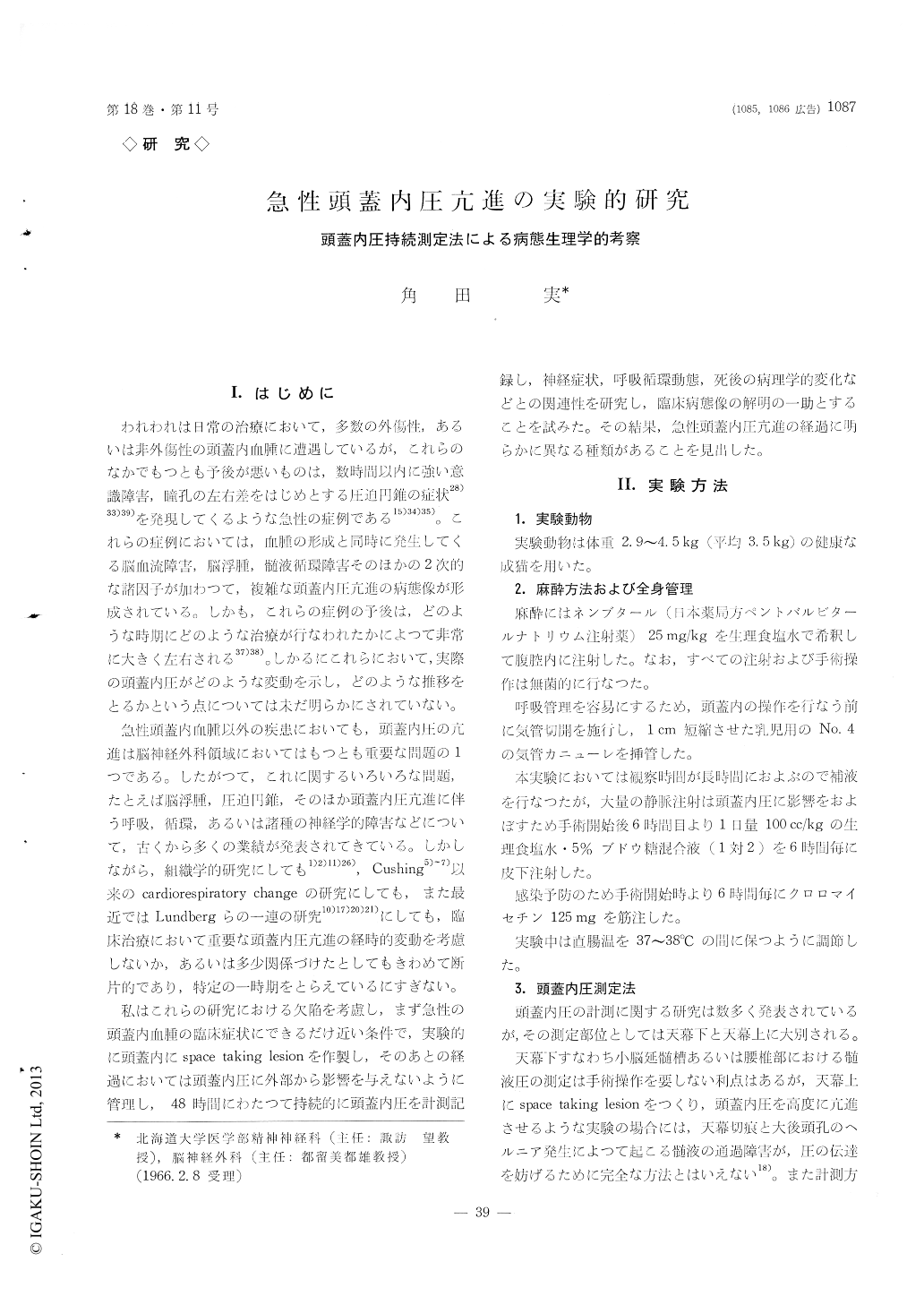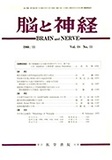Japanese
English
- 有料閲覧
- Abstract 文献概要
- 1ページ目 Look Inside
I.はじめに
われわれは日常の治療において,多数の外傷性,あるいは非外傷性の頭蓋内血腫に遭遇しているが,これらのなかでもつとも予後が悪いものは,数時間以内に強い意識障害,瞳孔の左右差をはじめとする圧迫円錐の症状28)33)39)を発現してくるような急性の症例である15)34)35)。これらの症例においては,血腫の形成と同時に発生してくる脳血流障害,脳浮腫,髄液循環障害そのほかの2次的な諸因子が加わつて,複雑な頭蓋内圧亢進の病態像が形成されている。しかも,これらの症例の予後は,どのような時期にどのような治療が行なわれたかによつて非常に大きく左右される37)38)。しかるにこれらにおいて,実際の頭蓋内圧がどのような変動を示し,どのような推移をとるかという点については未だ明らかにされていない。
急性頭蓋内血腫以外の疾患においても,頭蓋内圧の亢進は脳神経外科領域においてはもつとも重要な問題の1つである。したがつて,これに関するいろいろな問題,たとえば脳浮腫,圧迫円錐,そのほか頭蓋内圧亢進に伴う呼吸,循環,あるいは諸種の神経学的障害などについて,古くから多くの業績が発表されてきている。しかしながら,組織学的研究にしても1)2)11)26),Cushing5)〜7)以来のcardiorespiratory changeの研究にしても,また最近ではLundbergらの一連の研究10)17)20)21)にしても,臨床治療において重要な頭蓋内圧亢進の経時的変動を考慮しないか,あるいは多少関係づけたとしてもきわめて断片的であり,特定の一時期をとらえているにすぎない。
(1) Method of experiment
The experiment was carried out on adult mongrel cats. After being anesthetized with intraperitoneal pentobarbital sodium (25 mg/kg), the animals were fixed on stereotaxic apparatus. In order to maintain airway, tracheostomy was made to the all animals. A burr hole was made over the vertex and the dura was opened. A small dome made of plastic material with thin rubber bottom was placed over the burr hole and the dome was fixed to the skull water-tight with dental cement. The dome was filled with 0.2 cc of water and was connected to a physiological pre-ssure transducer.
Using this method, it was possible to record supra-tentorial pressure continuously without exposing to danger of infection for long period of time. Pressures of abdominal aorta and vena cava were also measured with pressure transducer through catheters introduced via femoral artery and vein.
Using a stereotaxic method, a thin polyethylene tube was inserted into various places in the right hemisphere. Through this tube, 0. 05 cc of paraffin-wax was injected into the hemisphere every 5 min-utes until the size of pupils became unequal.
For 48 hours after the completion of injection, in-tracranial pressure and arterial and venous pressures were continuously recorded. At the same time, the level of consciousness and the size of pupils were closely observed.
(2) Results
1) Transition of intracranial pressure and clinical symptoms :
The change of the intracranial pressure following to the completion of the injection of paraffin-wax varied from one animal to another.
However, with regard to the whole course of in-tracranial pressure and clinical symptoms, three major types were classified.
They are as follows :
Type A; The intracranial pressure keeps on in-creasing after the cessation of injection and animals cease within one to two hours after the completion of injection with taking a turn for the worse of clin-ical symptoms.
Type B; After the cessation of injection, the in-tracranial pressure temporarily decreases from 300 to 600 mmH2O with remission of symptoms, which stays at this level for 8 to 16 hours and then suddenly reelevates to the extremely high level and all animals expire.
Type C; The intracranial pressure declines to the level below 300 mmH2O after the completion of injec-tion with the improvement of clinical symptoms. No re-elevation of the intracranial pressure is seen in the next 48 hours.
2) Post-morten examination :
There was a good correlation between the location of the lesions and the clinical types mentioned above. In type A group, the lesions were found deep in the hemisphere close to the thalamus and type C was associated with the lesions locating relatively close to the hemispherical surface and more anteriorly than type A. In type B group, the lesions were situated between them.
Tentorial and tonsillar herniations were most mark-ed in type B but it was also seen in types A and C in various degrees.
In types A and C, the aqueduct was found to be flatten but it was still patent, though it was comple-tely obstructed by the compression resulted from temporal lobe herniation in type B.
(3) Conclusions
In type A, compensatory functions of the brain to the increased interacranial pressure were interfered by the direct injury to the vital center with deeply locat-ed lesions and so agonal status appeared in the early stage of the experiment.
In type B, dircet injury to the vital center by the injected mass seemed to play less important role and the animals died of secondary brain-stem compression which was promoted by herniations, cerebral edema and aqueduct-blockage.
In type C, it appeared the respiratory and circula-tory centers were not disturbed during the course of the experiment in spite of the most severe edematous change of the cerebral hemisphere on post-morten examination. Some compensatory functions to the in-creased intracranial pressure were presumably work-ing well.

Copyright © 1966, Igaku-Shoin Ltd. All rights reserved.


